Enhancement of Mechanical Properties and Porosity of Concrete Using Steel Slag Coarse Aggregate
Abstract
:1. Introduction
2. Experimental Methodology
2.1. Material Characterization
2.1.1. Aggregates
2.1.2. Binder
2.2. Experimental Programs, Apparatus, and Test Procedures
2.2.1. Mechanical Properties
2.2.2. Porosity
2.2.3. Scanning Electron Microscopy (SEM)
3. Experimental Results and Discussion
3.1. Physical Properties of Aggregates
3.2. Fresh Concrete Properties
3.3. Concrete Expansion
3.4. Dry Density of Concrete Mixes
3.5. Mechanical Properties
3.5.1. Stress–Strain Behavior of Concrete Mixes
3.5.2. Compressive Strength
3.5.3. Tensile strength of Concrete Mixes
3.6. Porosity of Concrete Mixes
3.7. Scanning Electron Microscopy (SEM) Analysis
4. Concluding Remarks
- The use of SSA as a replacement for BA in concrete shows significantly higher compressive and tensile strength, which was 73% higher when BA was fully replaced by SSA.
- Lower workability was noticed for the concrete made with SSA than BA, which could be attributed to the higher rough surface texture and higher angularity of SSA than BA as well as better interlocking, which reduces the mobility of fresh concrete.
- The concrete made with SSA exhibited higher expansion than the concrete made BA.
- A significantly lower porosity was observed for the concrete made with SSA than BA. The maximum decrease in porosity was observed when BA was fully replaced by SSA, and the decrease was 45.80% lower than BA concrete.
- A satisfactory relationship between strength (compressive and tensile) and porosity was observed, which is consistent with the literature.
- SEM images showed that SSA was denser and has a stronger ITZ, which leads to the higher strength of concrete. By contrast, BA has more voids and cracks on aggregate as well as at the ITZ, which explains the lower strength of this concrete.
- From the experimental results of the nine mixes, this study reveals that SSA can be used as a full replacement for BA since SSA is denser, less porous, higher angularity, and has excellent surface roughness, which provides better mechanical and durability performances. Furthermore, SSA concrete provides environmental solutions by reducing the dumping problem, economical, conservation of natural aggregate, and sustainable green construction material since burning brick produces a lot of CO2.
Author Contributions
Funding
Acknowledgments
Conflicts of Interest
References
- Domone, P.; Illston, J. Construction Materials: Their Nature and Behaviour, 4th ed.; Spon Press 270 Madison Avenue: New York, NY, USA, 2010. [Google Scholar]
- Mehta, P.K.; Monteiro, P.J. Concrete Microstructure, Properties and Materials; McGraww-Hill: New York, NY, USA, 2006. [Google Scholar]
- Miah, M.J.; Miah, M.S.; Alam, W.B.; Lo Monte, F.; Li, Y. Strengthening of RC beams by ferrocement made with unconventional concrete. Mag. Civ. Eng. 2019, 89, 94–105. [Google Scholar]
- Khern, Y.C.; Paul, S.C.; Kong, S.Y.; Babafemi, A.J.; Anggraini, V.; Miah, M.J.; Šavija, B. Impact of chemically treated waste rubber tire aggregates on mechanical, durability and thermal properties of concrete. Front. Mater. 2020, 7, 90. [Google Scholar] [CrossRef] [Green Version]
- Miah, M.J.; Ali, M.K.; Paul, S.C.; Babafemi, A.J.; Kong, S.Y.; Šavija, B. Effect of recycled iron powder as fine aggregate on the mechanical, durability, and high temperature behavior of mortars. Materials 2020, 13, 1168. [Google Scholar] [CrossRef] [Green Version]
- Miah, M.J.; Ali, M.K.; Paul, S.C.; Miah, M.S.; Haque, M.M.; Islam, M.S.; Islam, M.R. Impact of partial replacement of brick coarse aggregate by waste rubber tyre on the fresh and hardened properties of concrete. Key Engineering Materials (Accepted). ISSN: 1662-9795. In Proceedings of the 11th International Conference on Material and Manufacturing Technology (ICMMT 2020), Bangkok, Thailand, 24–26 April 2020. [Google Scholar]
- Jiang, Y.; Ling, T.-C.; Shi, C.; Pan, S.-Y. Characteristics of steel slags and their use in cement and concrete—A review. Resour. Conserv. Recycl. 2018, 136, 187–197. [Google Scholar] [CrossRef]
- Roychand, R.; Pramanik, B.K.; Zhang, G.; Setunge, S. Recycling steel slag from municipal wastewater treatment plants into concrete applications – A step towards circular economy. Resour. Conserv. Recycl. 2020, 152, 104533. [Google Scholar] [CrossRef]
- San-José, J.T.; Vegas, I.; Arribas, I.; Marcos, I. The performance of steel-making slag concretes in the hardened state. Mater. Des. 2014, 60, 612–619. [Google Scholar] [CrossRef]
- Saxena, S.; Tembhurkar, A.R. Impact of use of steel slag as coarse aggregate and wastewater on fresh and hardened properties of concrete. Constr. Build. Mater. 2018, 165, 126–137. [Google Scholar] [CrossRef]
- Adegoloye, G.; Beaucour, A.L.; Ortola, S.; Noumowé, A. Concretes made of EAF slag and AOD slag aggregates from stainless steel process: Mechanical properties and durability. Constr. Build. Mater. 2015, 76, 313–321. [Google Scholar] [CrossRef]
- Netinger, I.; Bjegovic, D.; Vrhovac, G. Utilisation of steel slag as an aggregate in concrete. Mater. Struct. 2011, 44, 1565–1575. [Google Scholar] [CrossRef]
- Pang, B.; Zhou, Z.; Xu, H. Utilization of carbonated and granulated steel slag aggregate in concrete. Constr. Build. Mater. 2015, 84, 454–467. [Google Scholar] [CrossRef]
- Abu-Eishah, S.I.; El-Dieb, A.S.; Bedir, M.S. Performance of concrete mixtures made with electric arc furnace (EAF) steel slag aggregate produced in the Arabian Gulf region. Constr. Build. Mater. 2012, 34, 249–256. [Google Scholar] [CrossRef]
- Qasrawi, H. Fresh properties of green SCC made with recycled steel slag coarse aggregate under normal and hot weather. J. Clean. Prod. 2018, 204, 980–991. [Google Scholar] [CrossRef]
- Qasrawi, H. The use of steel slag aggregate to enhance the mechanical properties of recycled aggregate concrete and retain the environment. Constr. Build. Mater. 2014, 54, 298–304. [Google Scholar] [CrossRef]
- Sheen, Y.-N.; Le, D.-H.; Sun, T.-H. Innovative usages of stainless steel slags in developing self-compacting concrete. Constr. Build. Mater. 2015, 101, 268–276. [Google Scholar] [CrossRef]
- Saeed, T.; Miah, M.J.; Khan, T.; Ove, A. Pollutant removal employing tidal flow constructed wetlands: Media and feeding strategies. Chem. Eng. J. 2020, 382, 122874. [Google Scholar] [CrossRef]
- ASTM. C136/C136M-14. Standard Test Method for Sieve Analysis of Fine and Coarse Aggregates; ASTM International: West Conshohocken, PA, USA, 2014. [Google Scholar]
- ASTM. C33/C33M-18. Standard Specification for Concrete Aggregates; ASTM International: West Conshohocken, PA, USA, 2018. [Google Scholar]
- BS EN 1097-3:1998. Tests for Mechanical and Physical Properties of Aggregates-Determination of Loose Bulk Density and Voids; British Standard Institutions: London, UK, 1998. [Google Scholar]
- ASTM. C187-16. Standard Test Method for Amount of Water Required for Normal Consistency of Hydraulic Cement Paste; ASTM International: West Conshohocken, PA, USA, 2016. [Google Scholar]
- ASTM. C191-19. Standard Test Methods for Time of Setting of Hydraulic Cement by Vicat Needle; ASTM International: West Conshohocken, PA, USA, 2019. [Google Scholar]
- ASTM. C109/C109M-16a. Standard Test Method for Compressive Strength of Hydraulic Cement Mortars (Using 2-in. or [50-mm] Cube Specimens); ASTM International: West Conshohocken, PA, USA, 2016. [Google Scholar]
- NFP. 18-454. Béton—Réactivité D’une Formule de Béton Vis-à-Vis de L’alcali-Réaction—Essai de Performance; AFNOR: La Plaine, French, December 2004. [Google Scholar]
- ASTM. C39/C39M-18. Standard Test Method for Compressive Strength of Cylindrical Concrete Specimens; ASTM International: West Conshohocken, PA, USA, 2018. [Google Scholar]
- ASTM. C496/C496M-17. Standard Test Method for Splitting Tensile Strength of Cylindrical Concrete Specimens; ASTM International: West Conshohocken, PA, USA, 2017. [Google Scholar]
- NFP. 18-459. Essai Pour Béton durci-Essai De Porosité et De Masse Volumique; AFNOR: La Plaine, France, 2010. [Google Scholar]
- Maslehuddin, M.; Sharif, A.M.; Shameem, M.; Ibrahim, M.; Barry, M.S. Comparison of properties of steel slag and crushed limestone aggregate concretes. Constr. Build. Mater. 2003, 17, 105–112. [Google Scholar] [CrossRef]
- Miah, M.J.; Kallel, H.; Carré, H.; Pimienta, P.; La Borderie, C. The effect of compressive loading on the residual gas permeability of concrete. Constr. Build. Mater. 2019, 217, 12–19. [Google Scholar] [CrossRef]
- Miah, M.J. The Effect of Compressive Loading and Cement Type on the Fire Spalling Behaviour of Concrete. Ph.D. Thesis, Université de Pau et des Pays de l’Adour, Pau, France, 19 October 2017. [Google Scholar]
- Rooholamini, H.; Sedghi, R.; Ghobadipour, B.; Adresi, M. Effect of electric arc furnace steel slag on the mechanical and fracture properties of roller-compacted concrete. Constr. Build. Mater. 2019, 211, 88–98. [Google Scholar] [CrossRef]
- Awoyera, P.O.; Olofinnade, O.M.; Busari, A.A.; Akinwumi, I.I.; Oyefesobi, M.; Ikemefuna, M. Performance of steel slag aggregate concrete with varied water-cement ratio. J. Teknol. (Sci. Eng.) 2016, 78, 125–131. [Google Scholar] [CrossRef] [Green Version]
- Barišic, I.; Dimter, S.; Rukavina, T. Strength properties of steel slag stabilized mixes. Compos. Part B 2014, 58, 386–391. [Google Scholar] [CrossRef]
- Tarawneh, S.A.; Gharaibeh, E.A.; Saraireh, F.M. Effect of using steel slag aggregate on mechanical properties of concrete. Am. J. Appl. Sci. 2014, 11, 700–706. [Google Scholar] [CrossRef]
- Nadeem, M.; Pofale, A.D. Utilization of industrial waste slag as aggregate in concrete applications by adopting taguchi’sapproach for optimization. Open J. Civ. Eng. 2012, 2, 96–105. [Google Scholar] [CrossRef] [Green Version]
- Chen, X.; Wu, S.; Zhou, J. Influence of porosity on compressive and tensile strength of cement mortar. Constr. Build. Mater. 2013, 40, 869–874. [Google Scholar] [CrossRef]
- Lian, C.; Zhuge, Y.; Beecham, S. The relationship between porosity and strength for porous concrete. Constr. Build. Mater. 2011, 25, 4294–4298. [Google Scholar] [CrossRef]
- Chan, Y.N.; Luo, X.; Sun, W. Compressive strength and pore structure of high-performance concrete after exposure to high temperature up to 800 °C. Cem. Concr. Res. 2000, 30, 247–251. [Google Scholar] [CrossRef]
- Luo, X.; Sun, W.; Chan, S.Y.N. Effect of heating and cooling regimes on residual strength and microstructure of normal strength and high-performance concrete. Cem. Concr. Res. 2000, 30, 379–383. [Google Scholar] [CrossRef]
- Paul, S.C.; Tay, Y.W.D.; Panda, B.; Tan, M.J. Fresh and hardened properties of 3D printable cementitious materials for building and construction. Arch. Civ. Mech. Eng. 2018, 18, 311–319. [Google Scholar] [CrossRef]
- Panda, B.; Singh, G.B.; Unluer, C.; Tan, M.J. Synthesis and characterization of one-part geopolymers for extrusion based 3D concrete printing. J. Clean. Prod. 2019, 220, 610–619. [Google Scholar] [CrossRef]
- Panda, B.; Noor Mohamed, N.A.; Paul, S.C.; Bhagath Singh, G.V.P.; Tan, M.J.; Šavija, B. The effect of material fresh properties and process parameters on buildability and interlayer adhesion of 3D printed concrete. Materials 2019, 12, 2149. [Google Scholar] [CrossRef] [Green Version]
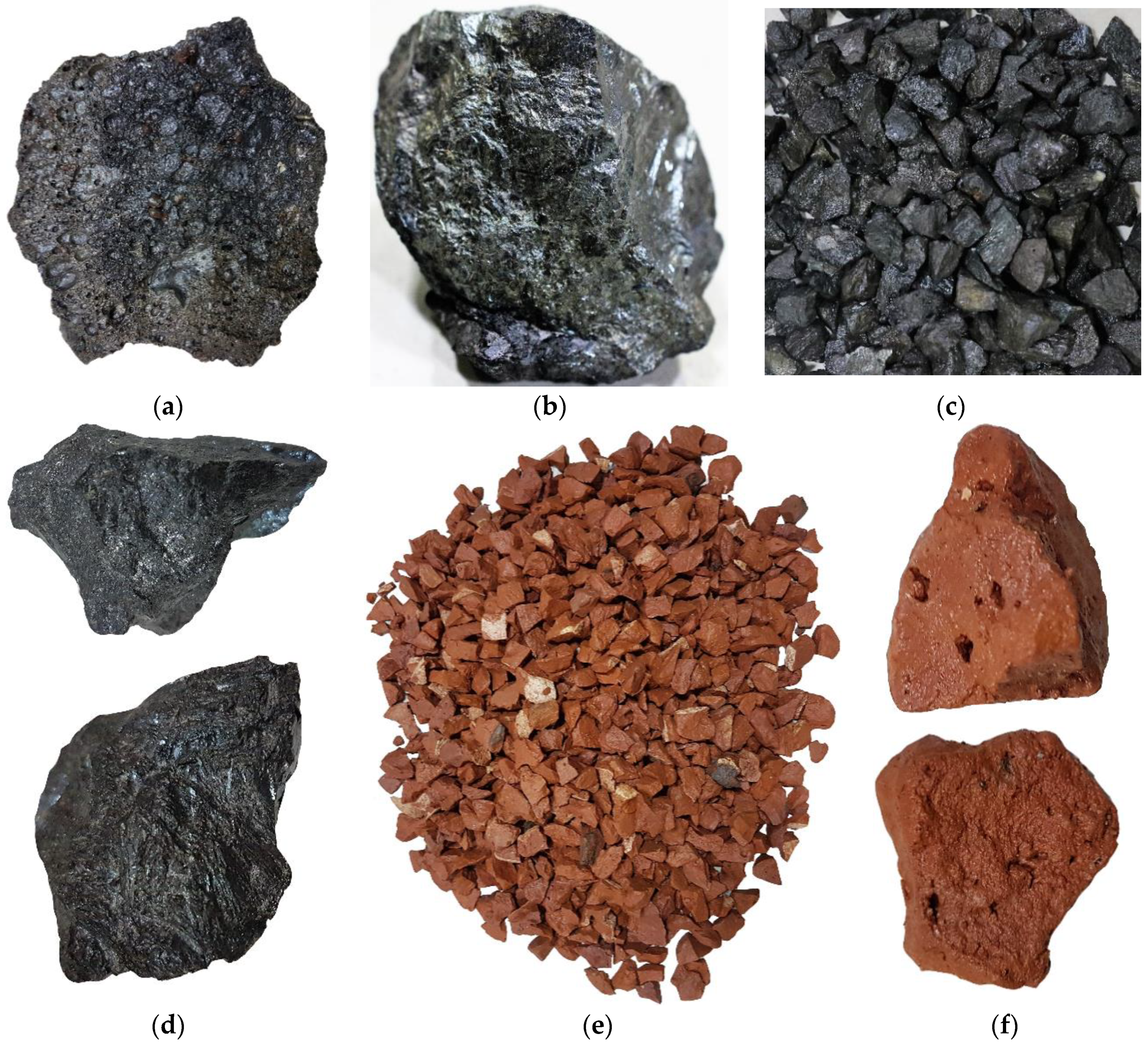
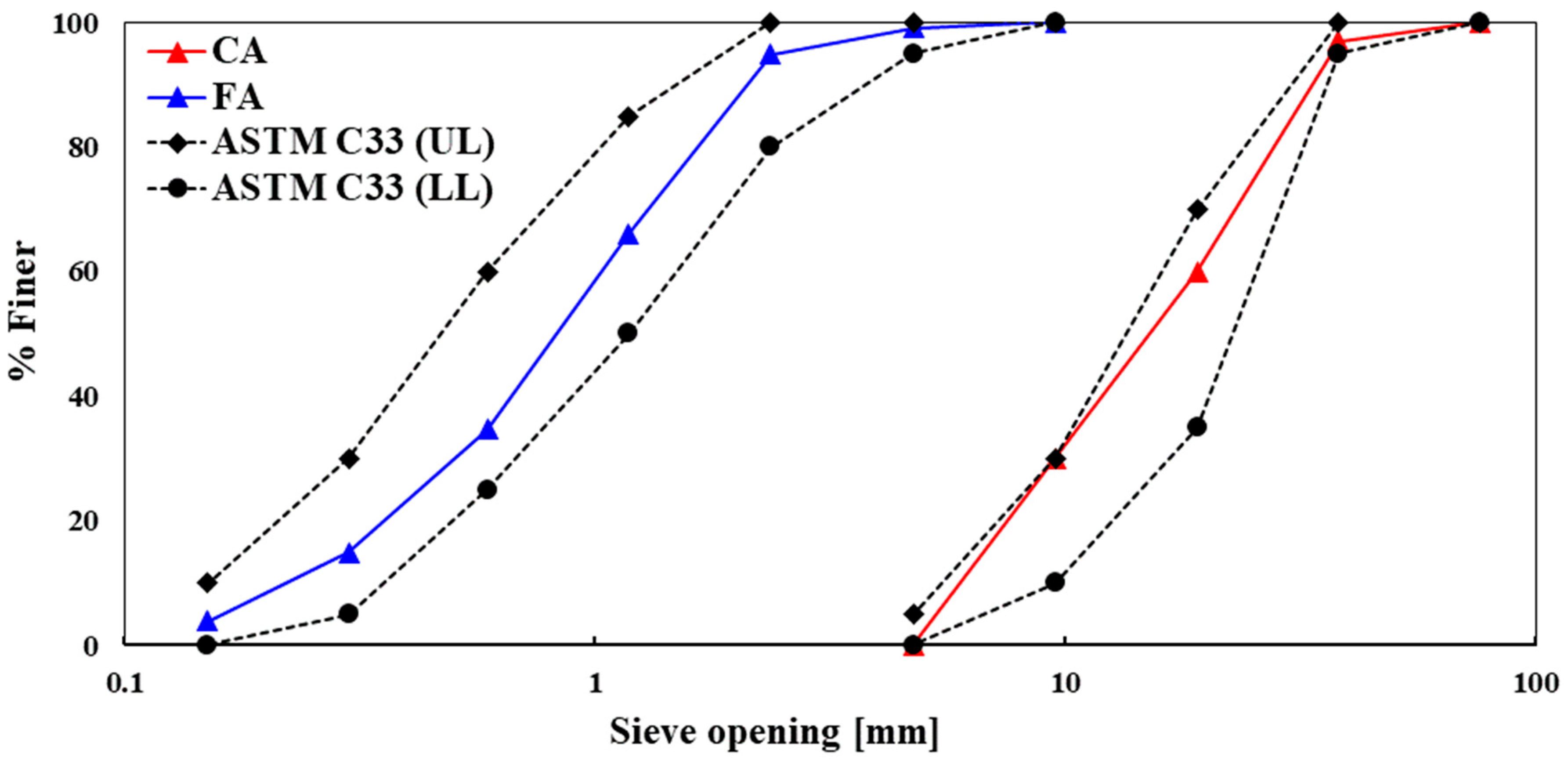
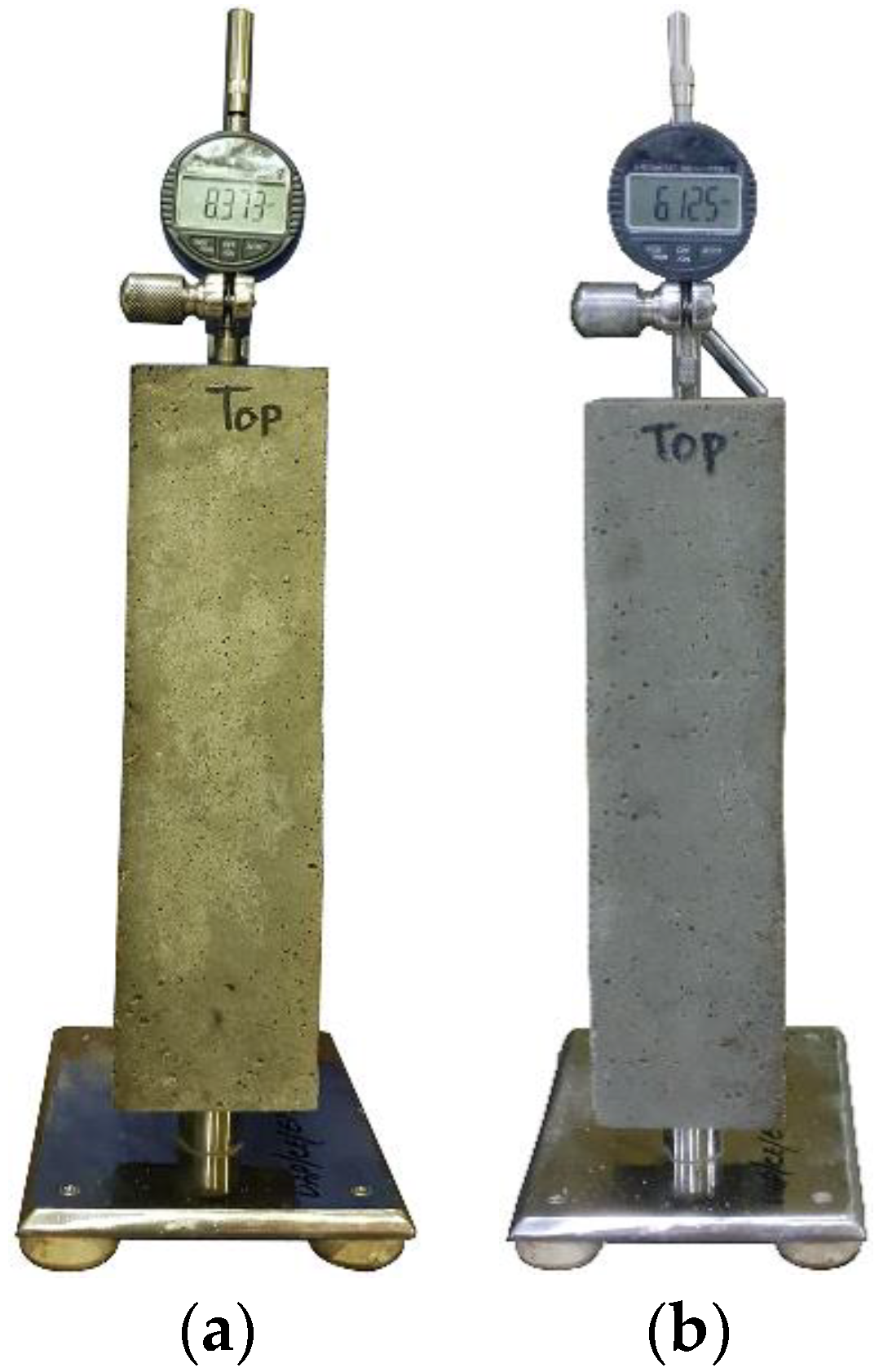

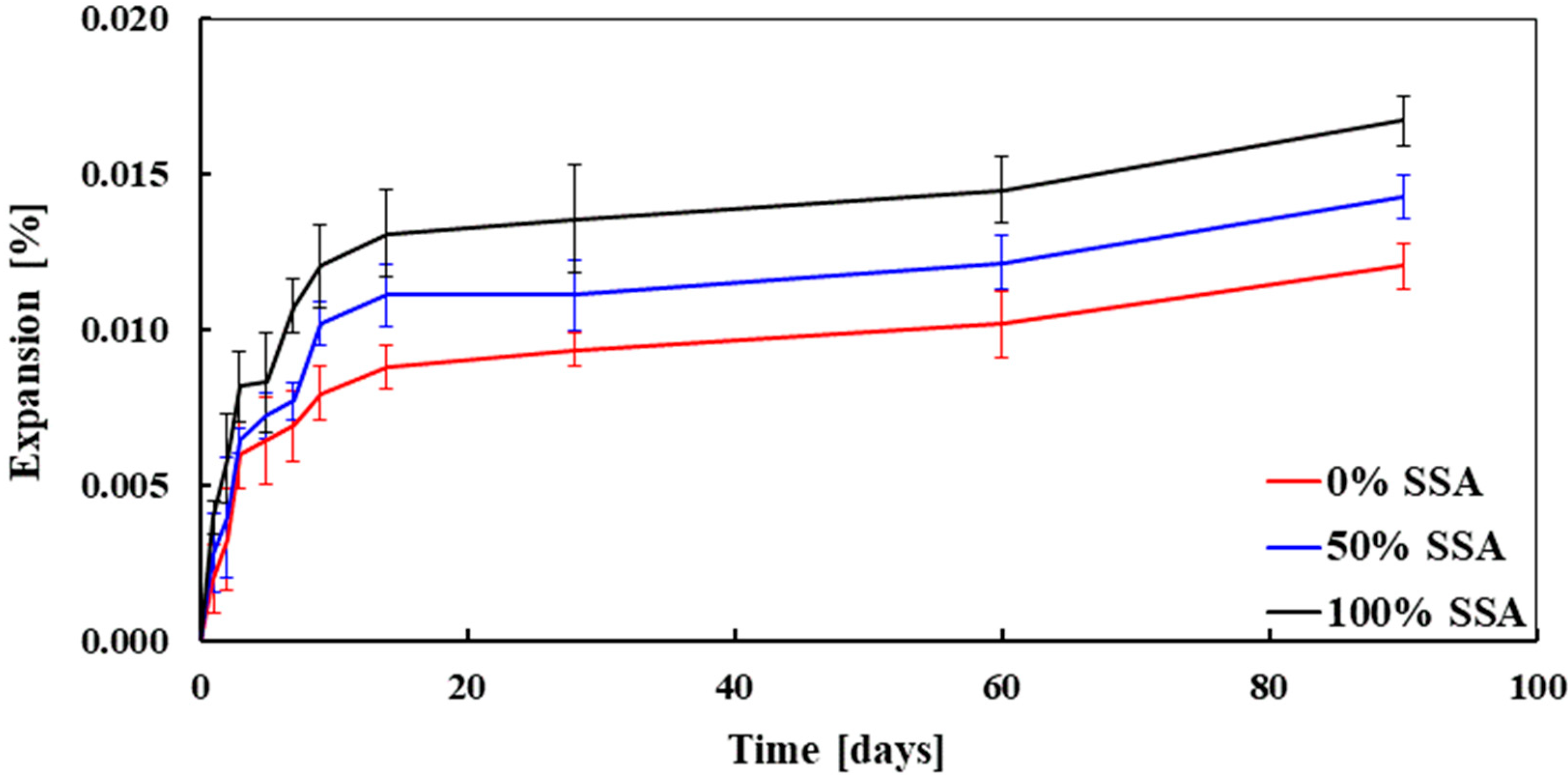

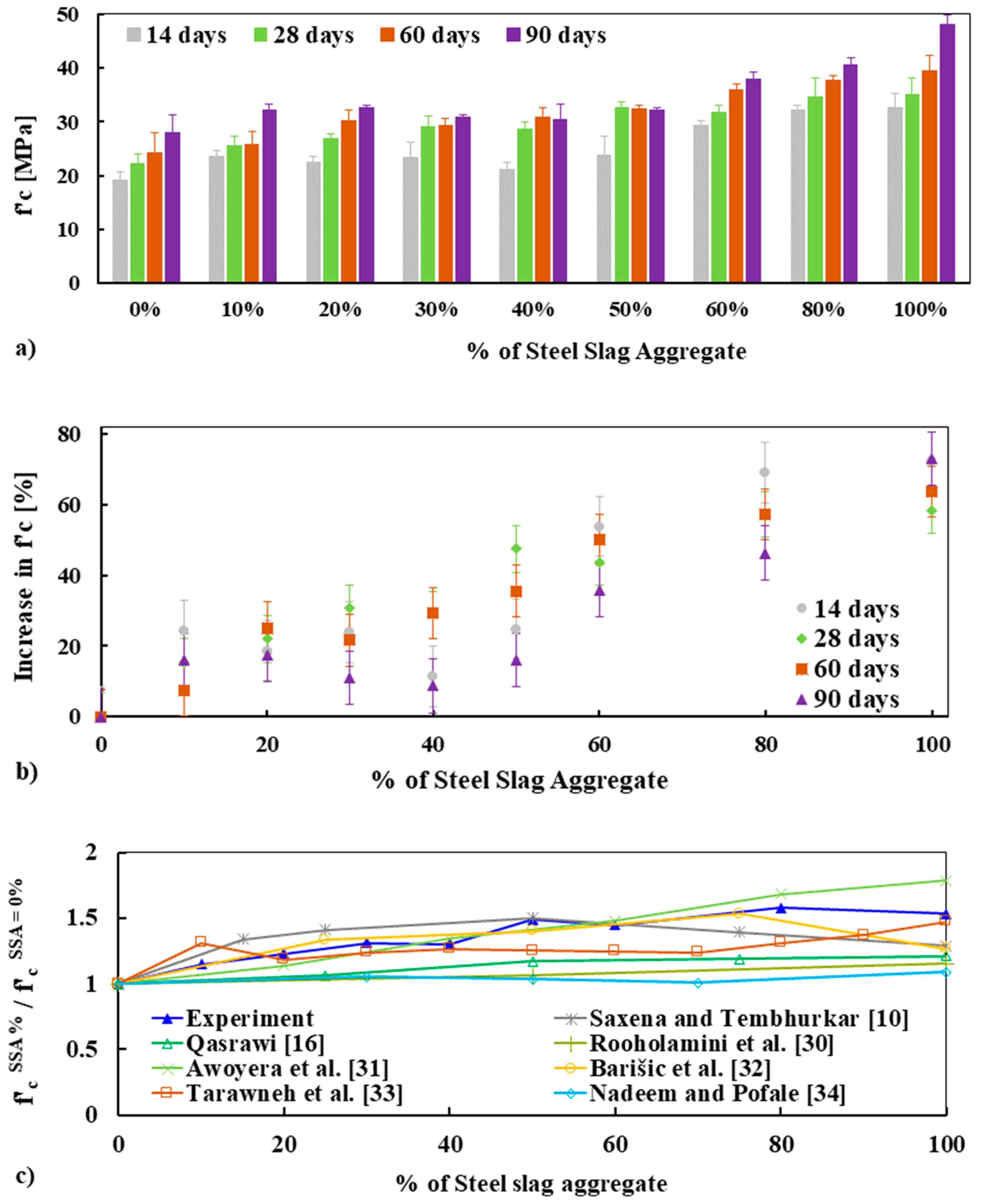
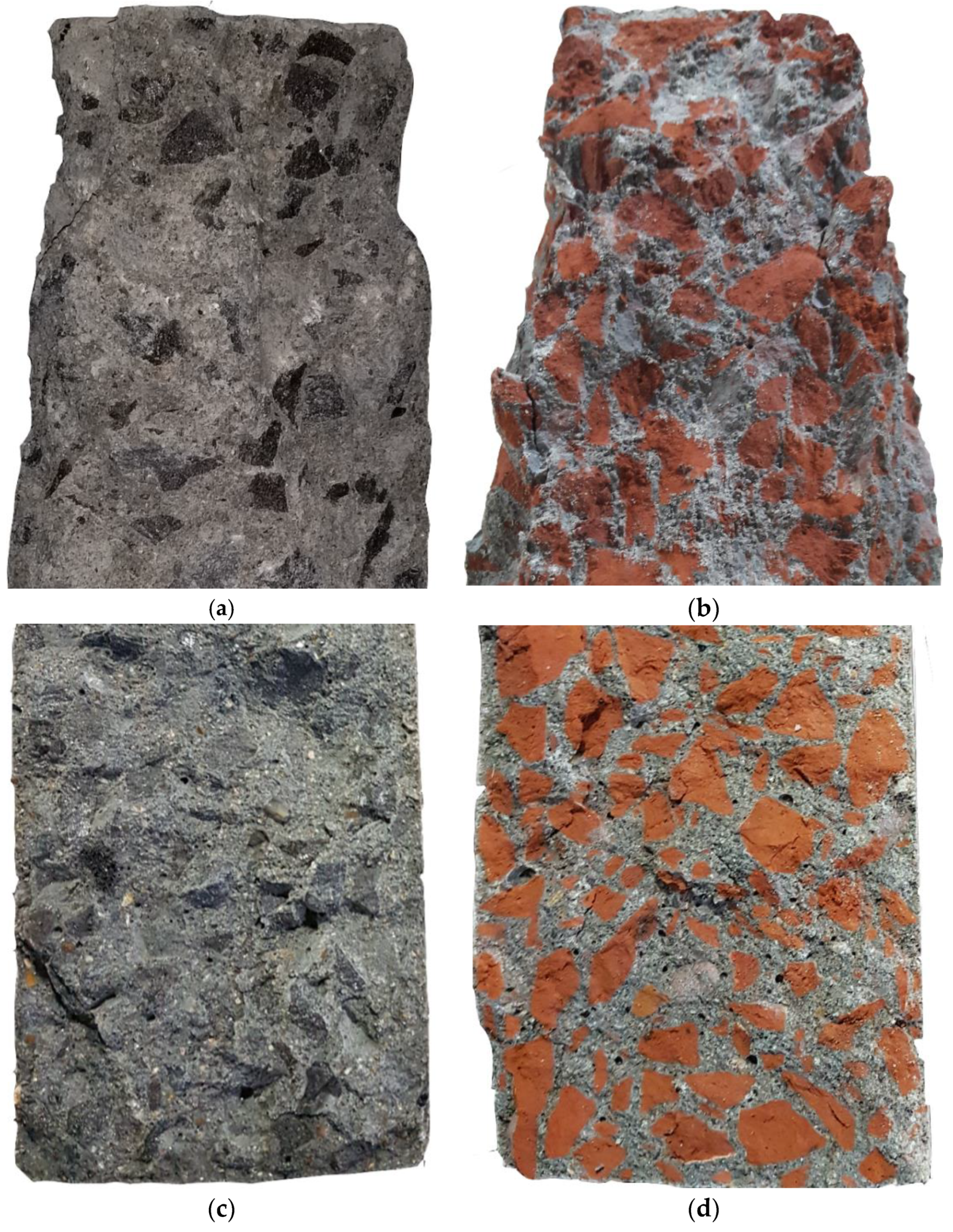

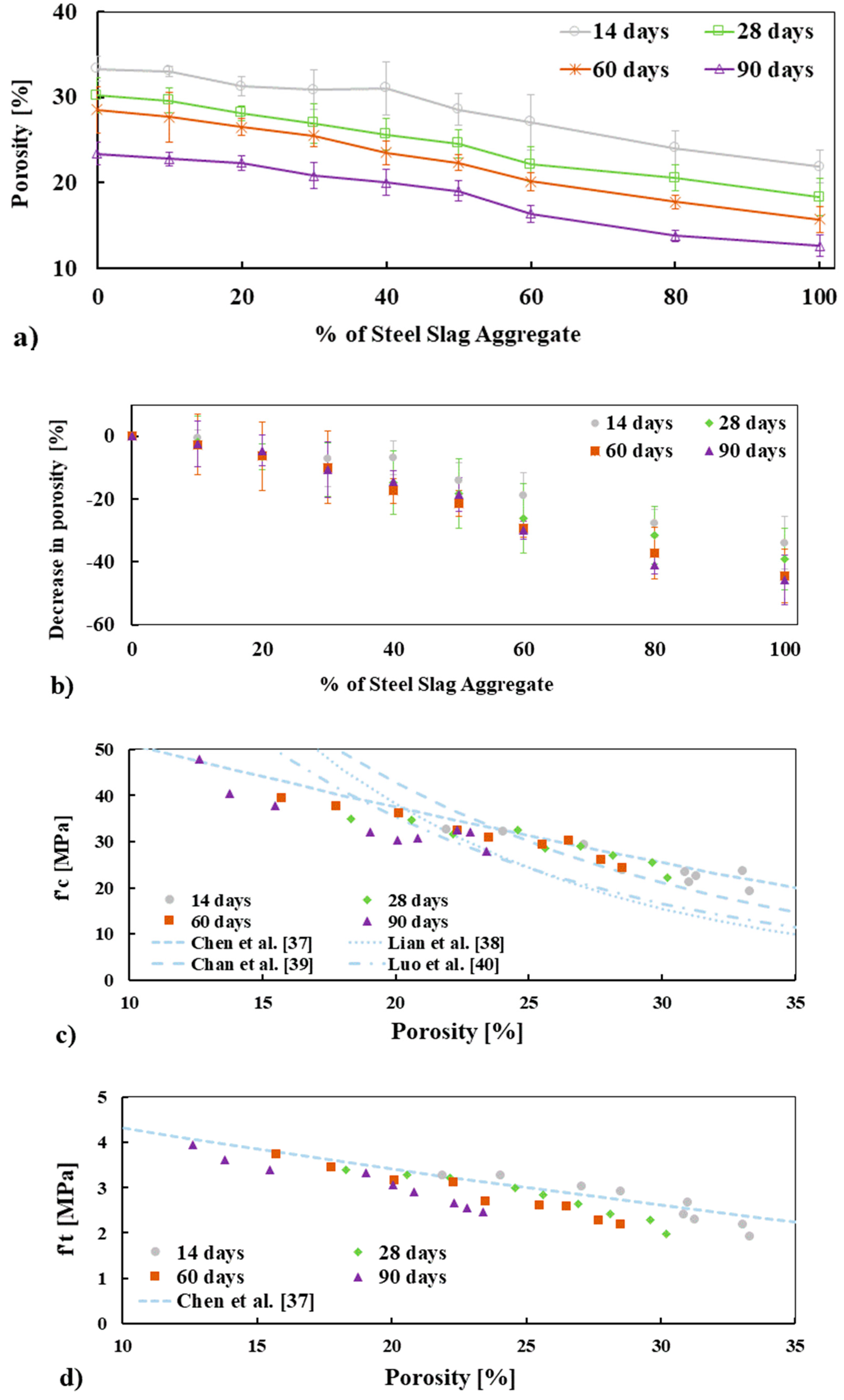
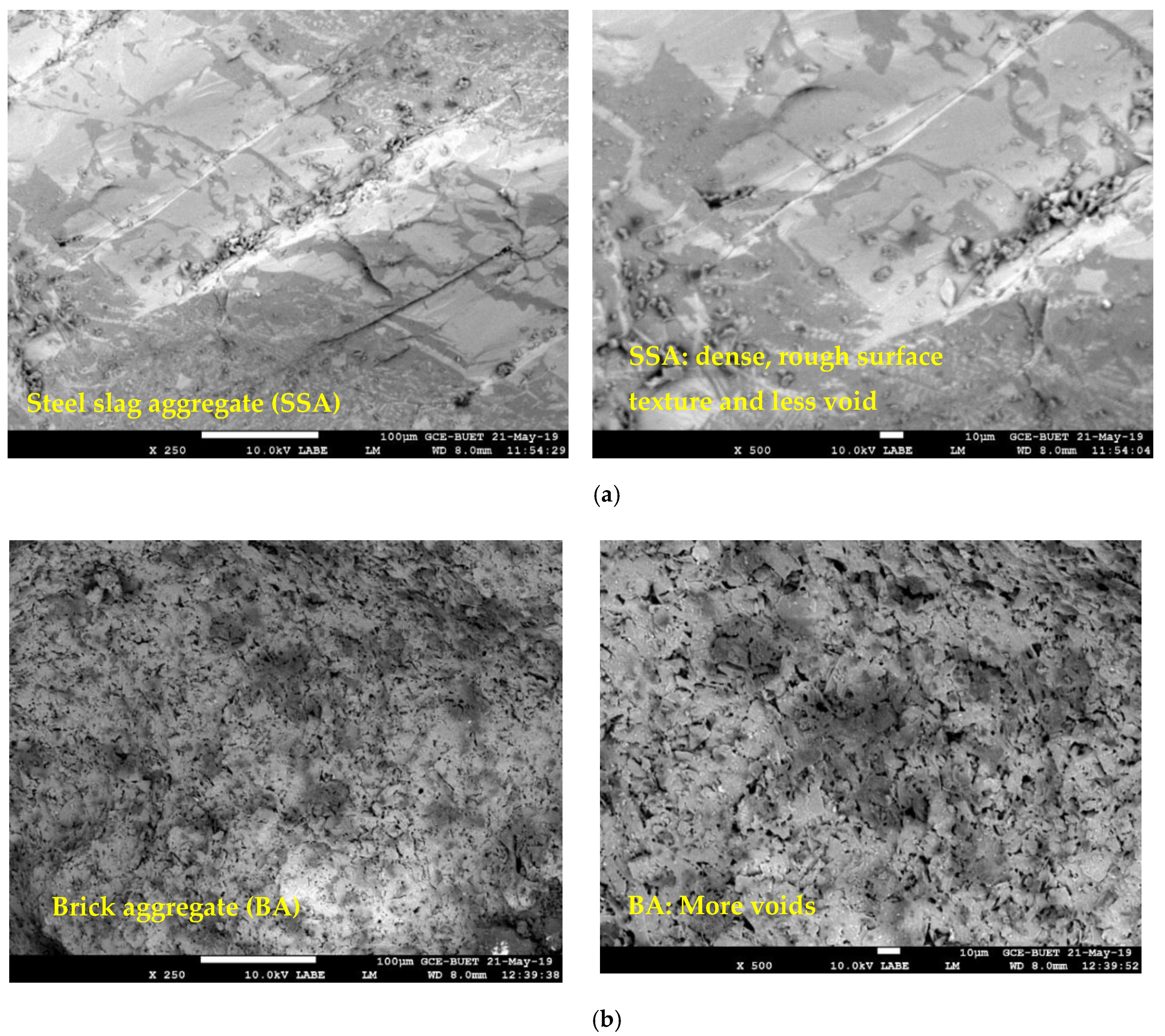
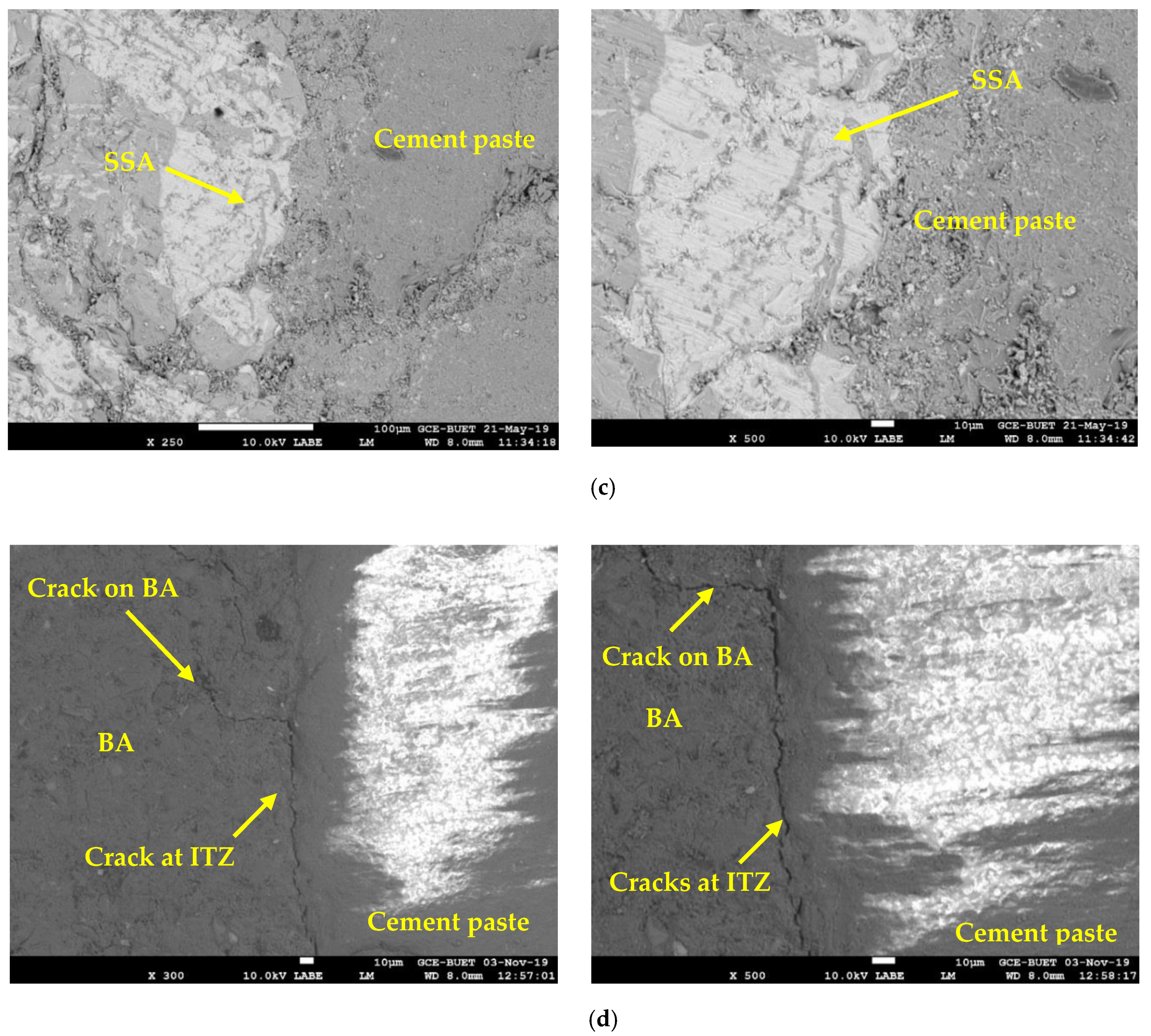
| Chemical Composition | BA (%) | SSA (%) |
|---|---|---|
| SiO2 | 60.43 | 26.18 |
| Fe2O3 | 14.27 | 44.39 |
| Al2O3 | 9.96 | 4.94 |
| K2O | 5.23 | 0.56 |
| CaO | 4.18 | 4.94 |
| TiO2 | 1.81 | 1.73 |
| MgO | 1.69 | 0.47 |
| Na2O | 0.90 | 0.45 |
| SO3 | 0.57 | 0.43 |
| MnO | 0.30 | 12.9 |
| P2O5 | 0.24 | 0.08 |
| ZnO | 0.10 | 2.33 |
| ZrO2 | 0.05 | 0.11 |
| SrO | 0.05 | 0.09 |
| Properties | Observed Values |
|---|---|
| Normal consistency (%) | 27.50 |
| Initial setting time (min) | 110 |
| Final setting time (min) | 360 |
| Compressive strength (MPa) at 3, 7, 14, and 28 days | 15.20, 19.50, 25.80 and 31.74 |
| Chemical composition: | |
| Clinker (%) | 80–94 |
| Slag and fly ash, limestone (%) | 6–20 |
| Gypsum (%) | 0–5 |
| Mix ID. | % SSA | % BA | Cement | Coarse Aggregate | Fine Aggregate | Water | |
|---|---|---|---|---|---|---|---|
| SSA | BA | ||||||
| 0% SSA | 0 | 100 | 350 | 0 | 775 | 872 | 158 |
| 10% SSA | 10 | 90 | 350 | 82 | 735 | 872 | 158 |
| 20% SSA | 20 | 80 | 350 | 172 | 687 | 872 | 158 |
| 30% SSA | 30 | 70 | 350 | 270 | 631 | 872 | 158 |
| 40% SSA | 40 | 60 | 350 | 377 | 566 | 872 | 158 |
| 50% SSA | 50 | 50 | 350 | 493 | 493 | 872 | 158 |
| 60% SSA | 60 | 40 | 350 | 616 | 411 | 872 | 158 |
| 80% SSA | 80 | 20 | 350 | 889 | 222 | 872 | 158 |
| 100% SSA | 100 | 0 | 350 | 1196 | 0 | 872 | 158 |
| Properties | BA | SSA | FA |
|---|---|---|---|
| Fineness modulus | 6.35 | 6.35 | 2.92 |
| *SSD unit weight (kg/m3) | 1120 | 1835 | 1530 |
| Specific gravity in SSD condition | 2.10 | 3.24 | 2.56 |
| Absorption capacity (%) | 20.00 | 1.00 | 3.10 |
| Los Angeles (LA) abrasion (%) | 42.70 | 19.40 | - |
| Impact value (%) | 28.10 | 8.95 | - |
| Crushing value (%) | 41.21 | 20.64 | - |
| Angularity number | 9.13 | 11.20 | - |
| Flakiness index (%) | 13.60 | 7.19 | - |
| Elongation index (%) | 40.67 | 24.19 | - |
| SSA | 0% | 10% | 20% | 30% | 40% | 50% | 60% | 80% | 100% |
|---|---|---|---|---|---|---|---|---|---|
| Slump (cm) | 21.70 | 20.40 | 21.00 | 20.90 | 19.50 | 18.70 | 18.30 | 16.90 | 16.20 |
| Temperature (°C) | 27.70 | 28.10 | 28.60 | 29.00 | 30.20 | 29.80 | 30.40 | 30.60 | 30.90 |
| Age | SSA | 0% | 10% | 20% | 30% | 40% | 50% | 60% | 80% | 100% |
|---|---|---|---|---|---|---|---|---|---|---|
| 14 days | ρ (Kg/m3) | 2078 | 2290 | 2405 | 2378 | 2429 | 2494 | 2540 | 2591 | 2633 |
| Increase (%) | 0.00 | 10.20 | 15.80 | 14.50 | 16.90 | 20.0 | 22.30 | 24.70 | 26.70 | |
| 28 days | ρ (Kg/m3) | 2132 | 2299 | 2351 | 2391 | 2439 | 2514 | 2555 | 2634 | 2668 |
| Increase (%) | 0.00 | 7.90 | 10.30 | 12.20 | 14.40 | 18.00 | 19.90 | 23.60 | 25.20 | |
| 60 days | ρ (Kg/m3) | 2117 | 2320 | 2373 | 2401 | 2465 | 2531 | 2571 | 2628 | 2691 |
| Increase (%) | 0.00 | 9.60 | 12.10 | 13.40 | 16.40 | 19.60 | 21.50 | 24.20 | 27.10 | |
| 90 days | ρ (Kg/m3) | 2145 | 2321 | 2385 | 2455 | 2487 | 2539 | 2595 | 2658 | 2724 |
| Increase (%) | 0.00 | 8.20 | 11.20 | 14.50 | 15.90 | 18.40 | 21.00 | 23.90 | 27.00 |
| Age | SSA | 0% | 10% | 20% | 30% | 40% | 50% | 60% | 80% | 100% |
|---|---|---|---|---|---|---|---|---|---|---|
| 14 days | (MPa) | 19.08 | 23.60 | 22.47 | 23.37 | 21.11 | 23.82 | 29.24 | 32.09 | 32.63 |
| CoV (%) | 8.94 | 4.98 | 4.61 | 11.72 | 6.68 | 14.60 | 3.35 | 2.88 | 8.39 | |
| 28 days | (MPa) | 22.24 | 25.63 | 26.98 | 29.02 | 28.57 | 32.63 | 31.73 | 34.67 | 34.98 |
| CoV (%) | 8.06 | 7.00 | 2.51 | 7.01 | 4.94 | 3.17 | 4.27 | 9.84 | 9.03 | |
| 60 days | (MPa) | 24.30 | 25.85 | 30.15 | 29.24 | 30.83 | 32.41 | 36.02 | 37.60 | 39.41 |
| CoV (%) | 15.13 | 9.21 | 6.87 | 4.82 | 5.53 | 2.09 | 2.87 | 2.75 | 7.16 | |
| 90 days | (MPa) | 28.03 | 32.18 | 32.63 | 30.83 | 30.37 | 32.18 | 37.83 | 40.54 | 47.99 |
| CoV (%) | 11.63 | 3.22 | 1.20 | 1.27 | 9.73 | 1.22 | 3.58 | 3.34 | 3.74 |
| Age | SSA | 0% | 10% | 20% | 30% | 40% | 50% | 60% | 80% | 100% |
|---|---|---|---|---|---|---|---|---|---|---|
| 14 days | (MPa) | 1.91 | 2.19 | 2.29 | 2.39 | 2.67 | 2.90 | 3.02 | 3.27 | 3.26 |
| CoV (%) | 15.28 | 9.48 | 6.36 | 2.31 | 4.29 | 7.21 | 6.40 | 4.39 | 1.49 | |
| 28 days | (MPa) | 1.98 | 2.28 | 2.42 | 2.63 | 2.83 | 2.99 | 3.21 | 3.29 | 3.38 |
| CoV (%) | 14.56 | 11.70 | 8.63 | 6.88 | 7.02 | 9.09 | 5.51 | 2.79 | 9.04 | |
| 60 days | (MPa) | 2.19 | 2.27 | 2.57 | 2.59 | 2.68 | 3.10 | 3.15 | 3.44 | 3.72 |
| CoV (%) | 11.68 | 14.99 | 12.04 | 12.13 | 14.83 | 9.55 | 10.64 | 2.45 | 6.45 | |
| 90 days | (MPa) | 2.46 | 2.56 | 2.67 | 2.91 | 3.06 | 3.33 | 3.38 | 3.61 | 3.96 |
| CoV (%) | 10.04 | 8.83 | 3.57 | 3.85 | 6.83 | 9.43 | 2.37 | 9.18 | 5.71 |
© 2020 by the authors. Licensee MDPI, Basel, Switzerland. This article is an open access article distributed under the terms and conditions of the Creative Commons Attribution (CC BY) license (http://creativecommons.org/licenses/by/4.0/).
Share and Cite
Miah, M.J.; Patoary, M.M.H.; Paul, S.C.; Babafemi, A.J.; Panda, B. Enhancement of Mechanical Properties and Porosity of Concrete Using Steel Slag Coarse Aggregate. Materials 2020, 13, 2865. https://doi.org/10.3390/ma13122865
Miah MJ, Patoary MMH, Paul SC, Babafemi AJ, Panda B. Enhancement of Mechanical Properties and Porosity of Concrete Using Steel Slag Coarse Aggregate. Materials. 2020; 13(12):2865. https://doi.org/10.3390/ma13122865
Chicago/Turabian StyleMiah, Md Jihad, Md. Munir Hossain Patoary, Suvash Chandra Paul, Adewumi John Babafemi, and Biranchi Panda. 2020. "Enhancement of Mechanical Properties and Porosity of Concrete Using Steel Slag Coarse Aggregate" Materials 13, no. 12: 2865. https://doi.org/10.3390/ma13122865
APA StyleMiah, M. J., Patoary, M. M. H., Paul, S. C., Babafemi, A. J., & Panda, B. (2020). Enhancement of Mechanical Properties and Porosity of Concrete Using Steel Slag Coarse Aggregate. Materials, 13(12), 2865. https://doi.org/10.3390/ma13122865








